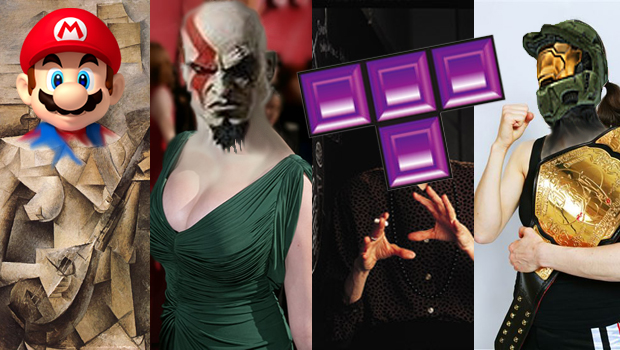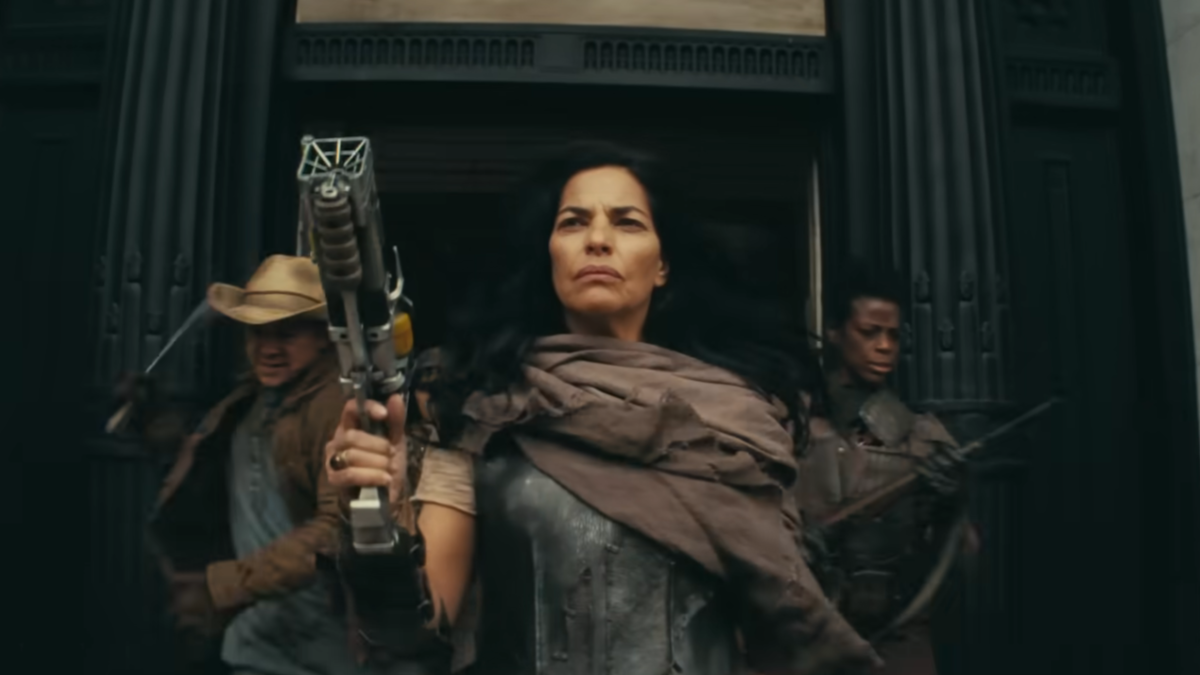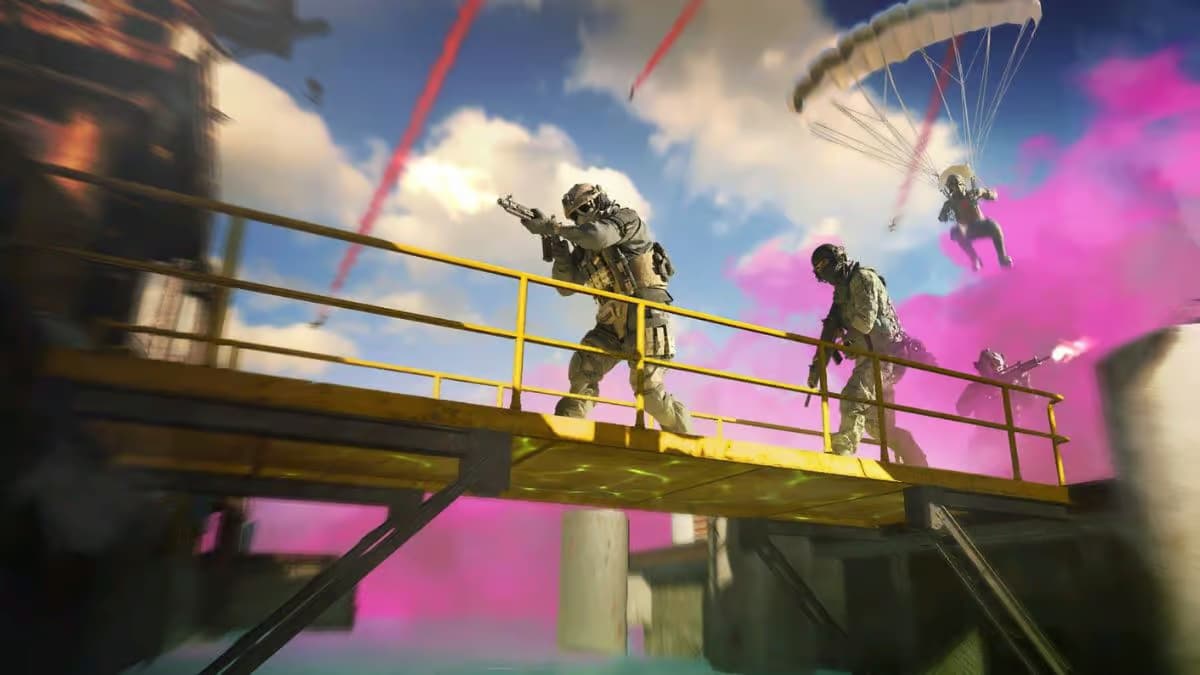[Talking to Women about Videogames is a series where Jonathan Holmes talks to different people who are women about the biggest videogame news of the week for some reason.]
The debate over the artistic merits (or lack thereof) of videogames has been going on for years. Every time I think it’s over, it pops up again. The passion on either side of the argument never seems to die down, while those on the outskirts are just desperate to put the whole debate to rest. Any topic that leads to this kind of endless impassioned debate (and debate about the debate itself) must have some greater meaning.
I think that meaning can be found in the deeply contrasting perceptions found on each side of the argument. Talking to someone who doesn’t think videogames are an art form can feel like talking to a Predator (the “Arnold Schwarzenegger hating” variety, not the “to catch a” variety). It’s like their eyes just don’t see the same world that mine sees. Where I see a face, or a sunset, they might see a random swirl of colors, or a bunch of amorphous blobs. That leads them to desperately try to convince me that there is a blob setting in the west, while I’m yelling at them about the breathtaking symphony of colors exploding in the sky right in front of us. We’re both sure that what we’re seeing is reality, and that schism between our two realities drives us nuts.
I’ve found the best way to deal with situations like these is to take on the differing perspective. From there, you can mentally team up with the person whom you’re “arguing” with, and try to guide them over to your way of seeing. They may not ever share your perspective, but by engaging with them, you can at least share the same reality for a little bit, and that can only lead to good things. So let’s take a look at why some people can’t see that videogames are an art form, and help to get them on the right track!
They’re blinded by the porn

That’s a big part of what keeps people from seeing gaming as an artistic medium. Videogames can be so many things simultaneously that it’s easy to get caught up on focusing on just one aspect, missing out on the potential artistry in the process. Most videogames work as some combination of art, pornography, education, and competition all in one, and pornography is usually the most eye-catching thing out of those four.
I’ve talked in the past about how I think all forms of communication can be split into those four categories: art (appeals to our humanity), pornography (appeals to our basest animal instincts), competition (determining our relative “worth” by comparing our objectively measurable skills to others), and education (to learn and/or teach information, techniques, and/or skills). I’ll briefly go over that idea again, as it factors pretty deeply into everything else going on here.

By my definition, “humanity” is anything that appeals to the unique frontal lobe structures that most human beings share. I’m talking about the interpretation of absurdist comedy, high-concept empathetic experiences, agonizing years of disappointment with oneself and others, the capacity to appreciate non-sexualized beauty, and countless other cerebral functions that only human beings seem to fully exercise. Art is anything that takes your brain and gets it going through those processes, while reflecting the psyche of the artist along the way.
Of course, sometimes art is naturally occurring. Remember when I was talking about how some people just see blobs where I see a sunset? I was actually talking about my cat. My cat doesn’t appreciate sunsets. Why would she? Sunsets don’t help you survive, reproduce, or know your place in the social order. Therefore, cats have no use for them. Cats can understand pornography (usually about eating mice or porking another cat), education (usually to learn how to catch mice or crap in imitation sand), and competition (usually focused on who’ll get to eat a mouse or crap in the imitation sand first), but they don’t understand art. One could even say that’s the definition of art — anything cats don’t like.

On the surface, many videogames appear to be about those kinds of cat-friendly, pornographic pursuits: eating, fighting, porking, etc. Then again, so are most movies, books, and TV shows. Anything made to appeal to the lowest common denominator is going to try to grab us by our drives.
What’s important is what happens after they’ve grabbed us. Most people first took notice of No More Heroes because the idea of killing a bunch of guys with a lightsaber grabbed them right in the… alpha male instincts. From there, it’s the series’ self-depreciating comedy, surrealist symbolism, and parody/tribute to action gaming and gamers that causes people to love it. They came for the porn, but they stayed for the art. In that way, No More Heroes isn’t all that different from the Mona Lisa, or any of the other painting that throws some cleavage right in the middle of the picture. Catch their eyes with the boobs, then keep their attention with the symbolism and artistry.
If is it “art” when da Vinci to does it, then why can’t videogames do it too?
They think art can’t be interactive

Speaking of the Mona Lisa, that’s a great example of artwork that’s lauded for its ability to make the viewer feel like they’re interacting with the art. No matter where you’re standing, it always feels like the Mona Lisa is making eye contact with you. That’s all down to how the painting is composed. It’s not that the Mona Lisa is always looking you in the eyes. It’s that the painting is designed to keep you coming back to her eyes.
Videogame design is no different. Most games are designed to move players’ eyes (and the rest of their nervous system) to where the designer wanted them to go, if the player knows it or not. It’s just that with videogames, there are many, many more potential levels of interaction beyond the two-dimensional, non-time-based planes of drawing and painting. Games use incentives like scores, goals, and linear storylines to guide players through experiences, as well as visual design and other cues to get them moving. Painting and game design are both about building the same thing. Game design just has a much bigger tool box to build with.
For whatever reason, some people (even some game designers) think that videogames can’t be art because they use those extra techniques to guide the player/viewer. That’s a maladaptive, narrow perspective, one that can only serve to limit how people experience games as both designers and players. Those extra tools shouldn’t diminish games’ legitimacy as an art form. If anything the more tools an art form utilizes, the more potential it has to move us.
They think games are toys

Pac-Man is another example of a game that guides your eyes around the picture plane in the style of a well-composed painting, taking your brain to various places in the process. The similarity between the study of Pac-Man‘s design and the study of compositional painting is pretty clear. So why do many “art scholars” overlook this fact?
My guess is that it’s partly because Pac-Man is something that you “play” with, as opposed to something that hangs on a wall. Though there is clearly some simplistic symbolism in the game (food, death), most people didn’t play Pac-Man for its “deeper meaning.” They played it because it was fun, like a toy or a puzzle. Therefore, it couldn’t be “art” to some people. As brainy as a lot of art scholars may be, they’re also prone to some automatic, illogical thinking.
A very common schema among adults in America (scholarly or otherwise) is that anything that you play with is a toy. These same people are also the types who often think that toys are only for children, and even worse, that children can’t appreciate art. I disagree with all three points. Children often appreciate amazing art (My Neighbor Totoro and E.T. immediately come to mind); toys are not always just for children (baseball bats, Richard Pryor, the NSFW Accommodator, etc.); and many things that people play with are art (Joseph Cornell’s boxes, Dave Cooper’s Furry Girl, and so on).

Ironically, installation art is something that gets a lot of respect in the “fine art” world, and it’s almost always something you can play with. Though most installations are built to guide the attendee through a particular space, it’s up to the antendee to determine where exactly to go and how to get there. That type of exploration for exploration’s sake (and the potential discoveries that come with it) is my definition of “play,” and there is no reason it should just be for children. Jane McGonigal’s new game Superbetter uses play to make recovering from serious illnesses fun. The iPhone app Zombies Run takes sprinting to the point where you may vomit and turns it into an adventure. By and large, fun makes things more involving and worthwhile. Why can’t that include art?
Of course, if a game is focused on being fun in the same way all the time, it could come off like a one-note tune. For me, a great game, or any other kind of art, can have the potential to be fun one second and frustrating the next, then calm, or suddenly hilarious, with the potential to leave you in tears by the end. A great videogame wouldn’t necessarily need to use cutscenes or voice acting to pull that off. Pure gameplay experiences like Super Meat Boy or Bit.Trip Complete have definitely given me that range of emotion without leaning on cinematics or traditional storytelling.
Of course, in order to experience that range of emotion, you have to be willing to actually play the game. That’s probably the most common barrier that prevents people from experiencing videogames as an art form.
They can’t play them

When people don’t understand something, they almost always don’t like it. When people don’t like something, they almost always disrespect it. That’s where a lot of the disrespect lobbed at gamers and gaming comes from. The amount of people who don’t understand how to play even the most basic (by Destructoid reader standards) games is astounding. I’ve recently tried to introduce some 35-50 year olds to the 2D Super Mario Bros. games, and they were too complicated for most of them. “Move and jump, and sometimes hold down the run button?” they’d say. “That’s too hard. I’ll stick with Angry Birds, thanks.”
The problem with that is, when a game is simple to play, people often lose respect for it for other reasons (see the earlier point about toys and things made for children). That’s when you get people saying that games are just “time wasters” or “pure entertainment,” as if “time waster” and “art” are mutually exclusive. Art can be a very entertaining waste of time. In fact, I’d go as far as to way it’s the most entertaining waste of time. There is nothing “productive” about analyzing art, but it’s just as rewarding as anything else adult life has to offer (assuming you enjoy that sort of thing.)
That’s part of why games like Journey and Flower are so special in today’s gaming landscape. They found a way to escape the “pure entertainment” and “time waster” stigma without being too intimidating or hard to understand. Despite being fun and simple to play, they are still largely recognized as art, or at the very least, as “more artistic,” by all who are willing to give them a try. A big part of that is because these games look like “art”, though they often play like glorified interactive screensavers.

Now that’s not to say that screensavers aren’t art, or aren’t “real” videogames. It’s just that in terms of actual game design, there usually isn’t too much complexity or ingenuity going on there. If you don’t appreciate that type of design, you might call it “shallow.” If you do appreciate that style of design, you might call it “minimalist.” Either way, that style of game is still art, as are Tetris, Super Mario Bros., God of War, and Halo.
That brings up a lingering question: Are some games more “art” than others? If so, what standards do people use to determine how artistic a game is? We’ll be talking more about that on next week’s episode. In the meantime, I’d love to hear why you think people can’t see that videogames are art. Is there something I’m not seeing? I’m willing to bet that there is.




